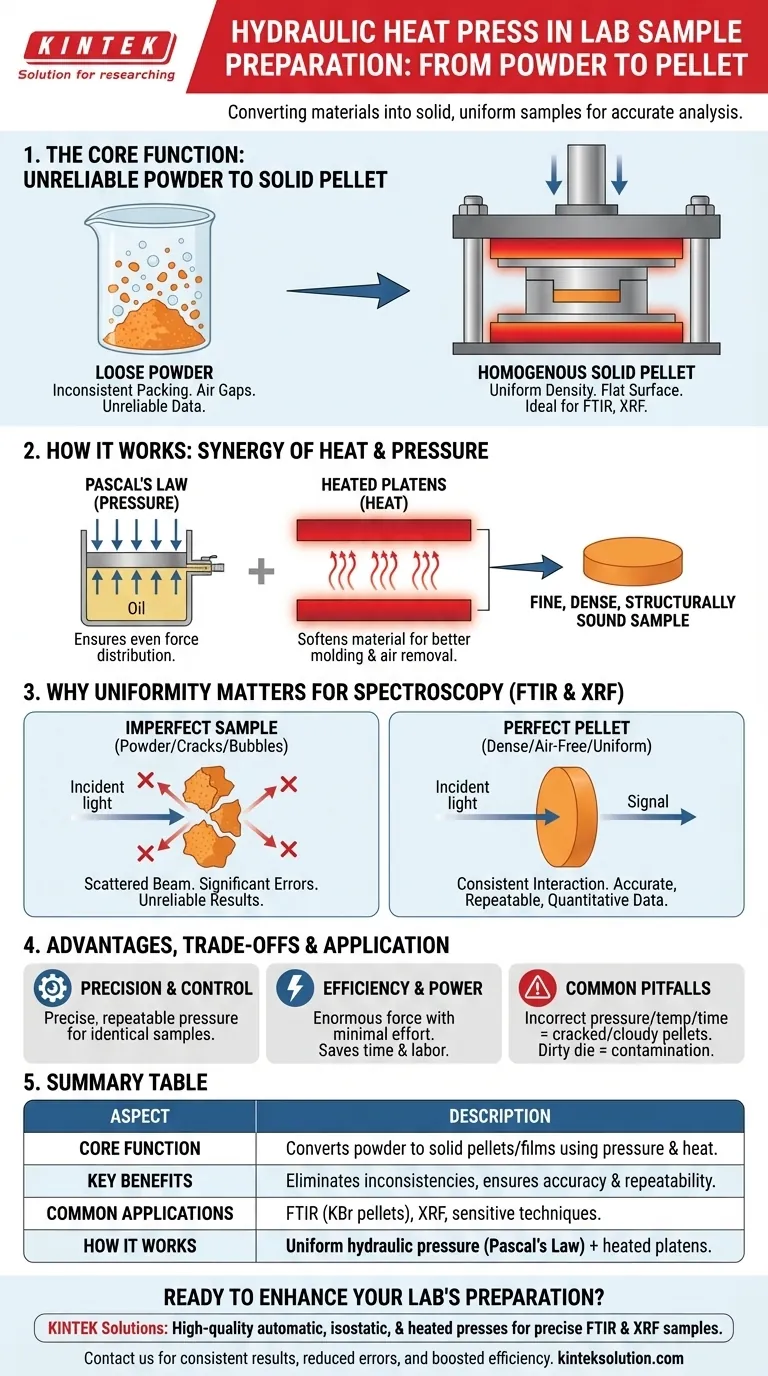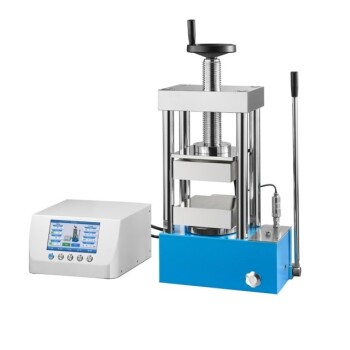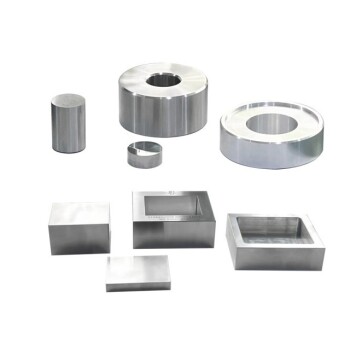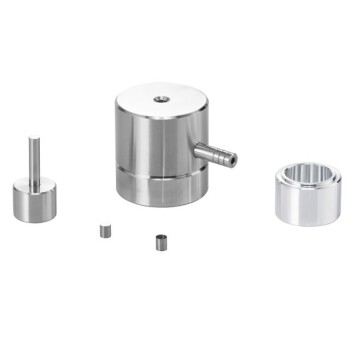In a laboratory setting, a hydraulic heat press is a fundamental tool used to convert powdered materials into solid, uniform samples. It accomplishes this by applying immense, evenly distributed pressure via a hydraulic system, often combined with controlled heat, to compress powders into dense pellets or thin films suitable for highly sensitive analytical techniques.
The core purpose of using a hydraulic heat press is to eliminate inconsistencies in a sample. By creating a homogenous, dense, and air-free pellet, researchers ensure that analytical measurements from techniques like FTIR or XRF spectroscopy are accurate, repeatable, and truly representative of the material being studied.
The Core Function: From Unreliable Powder to Solid Pellet
The Problem with Loose Powders
Analyzing a loose powder sample directly is often problematic for precision instruments. The particles have inconsistent packing, with air gaps and varying density throughout.
This non-uniformity can scatter the analytical beam (e.g., infrared light or X-rays), creating noise and distorting the results. This makes the data unreliable and difficult to reproduce.
The Solution: Creating a Homogenous Solid
A hydraulic heat press solves this by fundamentally changing the sample's physical form. It transforms the loose, inconsistent powder into a solid, stable disc—often called a pellet or thin film.
This new form has a uniform density and thickness, presenting an ideal, flat surface for analysis. This is essential for creating samples like KBr (potassium bromide) pellets for FTIR analysis, where the analyte must be evenly dispersed in a transparent matrix.
How It Works: The Synergy of Heat and Pressure
The process relies on two key principles working together. First, the hydraulic cylinder applies force based on Pascal's Law, transmitting pressure evenly through a confined fluid (like oil) to the sample die. This ensures the entire sample is compressed with uniform force.
Simultaneously, heated plates (platens) warm the sample. This heat helps to soften the material, allowing it to mold together more effectively, preventing cracks and ensuring that all air pockets are forced out. The result is a fine, dense, and structurally sound sample.
Why Uniformity is Critical for Spectroscopic Analysis
The Goal of Spectroscopy (FTIR & XRF)
Techniques like FTIR (Fourier Transform Infrared Spectroscopy) and XRF (X-ray Fluorescence) work by directing a beam of energy at or through a sample and measuring the interaction.
FTIR measures which frequencies of infrared light a sample absorbs, revealing its molecular bonds. XRF bombards the sample with X-rays and measures the secondary "fluorescent" X-rays emitted to determine its elemental composition.
The Impact of an Imperfect Sample
The accuracy of these techniques depends entirely on consistent interaction between the beam and the sample.
If a pellet has air bubbles, internal cracks, or uneven density, the beam will scatter unpredictably. This scattering introduces significant errors, weakens the desired signal, and can make it impossible to obtain accurate quantitative data or even a clear qualitative identification.
Understanding the Advantages and Trade-offs
Precision and Control
The primary advantage of a hydraulic system is the high degree of control it offers. The operator can apply a precise, repeatable amount of pressure, ensuring that multiple samples prepared for a comparative study are virtually identical in their physical properties.
Efficiency and Power
Hydraulic presses can generate enormous force with minimal operator effort. This is not only energy-efficient but also saves significant time and labor in a busy lab environment, allowing for rapid sample preparation.
Common Pitfalls to Avoid
While powerful, the press is a tool that requires proper technique. The most common source of error is not the machine, but its operation.
Using incorrect pressure, temperature, or holding time can result in cracked or cloudy pellets. Furthermore, sample contamination from a dirty die set can introduce impurities that will show up in the final analysis. The quality of the result is directly tied to the quality of the preparation.
Applying This to Your Sample Preparation
For any researcher, the goal is to produce the best possible data. A hydraulic heat press is a foundational part of achieving that.
- If your primary focus is quantitative analysis: The press's ability to create highly consistent pellets is paramount, as this ensures that differences in measurement are due to the sample chemistry, not physical variation.
- If your primary focus is qualitative identification: The press ensures you get a clear, strong signal by creating a dense, air-free sample that minimizes beam scattering and analytical noise.
- If your primary focus is laboratory throughput: The speed, power, and ease of use of a hydraulic system make it the most efficient choice for preparing a large number of samples without sacrificing quality.
Ultimately, a hydraulic heat press transforms an unreliable variable—sample form—into a controlled constant, enabling you to trust your analytical results.
Summary Table:
| Aspect | Description |
|---|---|
| Core Function | Converts powdered materials into solid, uniform pellets or thin films using pressure and heat. |
| Key Benefits | Eliminates inconsistencies, ensures accurate analytical results, and improves repeatability in spectroscopy. |
| Common Applications | FTIR spectroscopy (e.g., KBr pellets), XRF analysis, and other sensitive lab techniques. |
| How It Works | Applies uniform hydraulic pressure based on Pascal's Law, often with heated platens for better molding. |
Ready to enhance your lab's sample preparation with reliable hydraulic heat presses? KINTEK specializes in high-quality lab press machines, including automatic, isostatic, and heated models, designed to deliver precise, uniform samples for accurate FTIR and XRF analysis. Our equipment helps laboratories achieve consistent results, reduce errors, and boost efficiency. Contact us today to discuss your needs and discover how KINTEK can support your research goals!
Visual Guide

Related Products
- Automatic High Temperature Heated Hydraulic Press Machine with Heated Plates for Lab
- Automatic Heated Hydraulic Press Machine with Hot Plates for Laboratory
- 24T 30T 60T Heated Hydraulic Lab Press Machine with Hot Plates for Laboratory
- Laboratory Hydraulic Press 2T Lab Pellet Press for KBR FTIR
- Automatic Heated Hydraulic Press Machine with Heated Plates for Laboratory
People Also Ask
- What is a heated hydraulic press and what are its main components? Discover Its Power for Material Processing
- What are the applications of hydraulic heat presses in material testing and research? Enhance Precision and Reliability in Your Lab
- Why is a hydraulic heat press critical in research and industry? Unlock Precision for Superior Results
- What role does a heated hydraulic press play in powder compaction? Achieve Precise Material Control for Labs
- How does a heated hydraulic press assist in thin film preparation? Achieve Uniform Films for Accurate Analysis



















